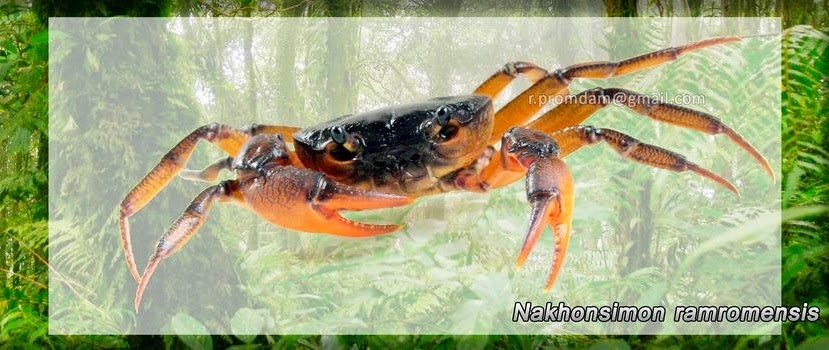| Image may be NSFW. Clik here to view.  |
| Nakhonsimon ramromensis Promdam, Nabhitabhata & Ng, 2014 |
Abstract
A new genus and species of potamid crab, Nakhonsimonramromensis, is described from Nakhon Si Thammarat, southern Thailand. The new genus resembles Stoliczia and Johora from Peninsular Thailand and Malaysia in general features, but can be distinguished by the form of the male thoracic sternites 3 and 4, and the structure of the gonopods.
Key words. Nakhonsimonramromensis, new genus, new species, Brachyura, Potamidae, freshwater crab, Peninsular Thailand, taxonomy
TAXONOMY
Family Potamidae Ortmann, 1896
Subfamily Potamiscinae Bott, 1970
Nakhonsimon, new genus
Type species. Nakhonsimonramromensis, new species, designated herein.
Etymology. The name is an arbitrary combination of Changwat (= Province) Nakhon Si Thammarat, the type locality of the type species, in combination with the genus name Potamon. Gender of genus neuter.
Habitat. Adults of this species appear to be completely terrestrial, as they were found far away from any permanent water sources; the holotype male was found in a temporary pool on the highest point of the mountain ridge (about 996 m above sea level). Smaller crabs were observed in a phyotelm on a tree trunk that grows near the stream. Most juveniles were found beneath rocks in the main stream.
The gecarcinucid Phricotelphusaaedes (Kemp, 1923) was collected in the same vicinity as Nakhonsimonramromensis.
Distribution. So far only known from the type locality on Khao Ram Rome, Changwat Nakhon Si Thammarat, Peninsular Thailand, but can probably be found in adjacent areas as well.
Rueangrit Promdam, Jaruwat Nabhitabhata & Peter K. L. Ng. 2014. Nakhonsimonramromensis, A New Genus and Species of Freshwater Crab (Crustacea: Decapoda: Brachyura: Potamidae) from Nakhon Si Thammarat, Peninsular Thailand. Raffles. Bull. Zool. 62: 496–500.
http://lkcnhm.nus.edu.sg/nus/images/data/raffles_bulletin_of_zoology/zoology_volume_62/62rbz496-500.pdf
http://lkcnhm.nus.edu.sg/nus/images/data/raffles_bulletin_of_zoology/zoology_volume_62/62rbz496-500.pdf
